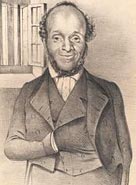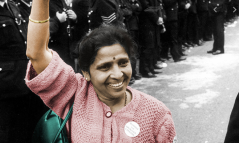Migration Museum competition – moving stories
23 October 2019
Black History month is a great opportunity to reflect on the contribution made by people of colour to shaping the history of our nation. I feel privileged that I get to think, write and talk about history as part of my job, and that it is helping diversify the curriculum students get taught in schools. If you are teaching the migration themes at GCSE, you have a wonderful opportunity to enter our Migration Museum competition with your students, enhancing their learning on the way to potentially winning a fabulous prize!
The competition is up and running now. Essentially, teams of up to four students design an exhibition to go in the Migration Museum. This should be drawn from an aspect of the study of migration they have been doing for their GCSE. By February, students should have drawn up their plans, designed an appropriate way of showcasing them, and submitted it to us.
There is a full teacher briefing pack available. This gives an overview of the competition, the administration, deadlines, help and guidance available, and how the competition will be judged. If you’re lucky enough to make it onto the finalists’ shortlist, you and your team will be invited to an evening at the Migration Museum in spring next year to present to the judges. One lucky team will be selected to win, and in doing so they will have the choice of a trip to Paris or Dublin, mostly likely to be taken in summer 2020.
Why should you and your students enter the competition?
Last year, the centres that did enter reported their students were even more engaged in the content and assessment of the topic, developed vital presentation and teamwork skills, and thoroughly enjoyed their participation. Many teachers said that despite their reservations about the time and effort spent on the competition, it actually augmented and complemented their teaching (and the students’ learning) of the migration units.
From my work as a History Subject Advisor, I’ve picked out two lives that caused me to pause and reflect with wonder at the challenges faced and overcome by individuals in our past. These stories come from the OCR GCSE History B unit Migrants to Britain c.1250-present, supported by Hodder’s OCR endorsed textbook.
 A mixed race, four feet eleven son of a former slave, William Cuffay rose from apprentice tailor to helping lead one of the most significant political movement in nineteenth century Britain, the Chartists. Betrayed by a government spy and convicted of ‘conspiring to levy war’ against Queen Victoria, he was transported to Tasmania, where until his death at the age of 82 he continued to fight for more democracy, shorter working days, and the rights of workers.
A mixed race, four feet eleven son of a former slave, William Cuffay rose from apprentice tailor to helping lead one of the most significant political movement in nineteenth century Britain, the Chartists. Betrayed by a government spy and convicted of ‘conspiring to levy war’ against Queen Victoria, he was transported to Tasmania, where until his death at the age of 82 he continued to fight for more democracy, shorter working days, and the rights of workers.
 Jayaben Desai migrated to Britain in the 1960s, taking up low paid work as a sewing machinist and later a film processor. After being ordered to work overtime, she initiated a strike among the mostly female Asian workforce. The strike lasted for two years and railed against working conditions, pay inequality, and institutionalised racism. Her colourful personality and skilful use of the media contributed to the strike’s popularity, and the involvement of white, working class men in supporting striking female Asian workers is a turning point in race relations in the UK.
Jayaben Desai migrated to Britain in the 1960s, taking up low paid work as a sewing machinist and later a film processor. After being ordered to work overtime, she initiated a strike among the mostly female Asian workforce. The strike lasted for two years and railed against working conditions, pay inequality, and institutionalised racism. Her colourful personality and skilful use of the media contributed to the strike’s popularity, and the involvement of white, working class men in supporting striking female Asian workers is a turning point in race relations in the UK.
The stories of Cuffay and Desai largely faded from popular consciousness, but are now being brought back. Desai was selected by BBC Radio 4’s Woman’s Hour for their 2016 Power List, and statues and memorials to Cuffay are planned in Australia. At OCR we are very proud that thousands of students are now re-discovering the important contributions made to British society by people of colour.
I’m immensely grateful that I have the time and space to be able to reflect on these stories, and the countless millions of other lives that have made such enormous and often undocumented contributions to our human story. If you’re teaching migration already, seriously consider the competition; if not, the Migration Museum is always looking to make contact with schools and help diversify the curriculum even further.
Get in touch
If you’d like to find out more about the Migration Museum competition, register your interest and to arrange an in-school visit to introduce the competition to you and pupils please email liberty@migrationmuseum.org.
You can also share your experiences and submit your comments below. If you have any specific questions, email us at history@ocr.org.uk and for regular updates about anything History related, sign up for email updates or follow us on Twitter @OCR_History.
About the author
Asher Goodenough - Subject Specialist - History
 Asher has worked at OCR since September 2015, and is a History Subject Specialist and is Chair of the LGBT+ Network at Cambridge Assessment. His degree is in Modern History with a focus on British and American history since the 19th century. Previously, Asher was a teacher of History, Co-ordinator of Critical Thinking, and Head of History, working in schools in England and Germany. In his spare time he is an avid cricket, travel and cooking enthusiast.
Asher has worked at OCR since September 2015, and is a History Subject Specialist and is Chair of the LGBT+ Network at Cambridge Assessment. His degree is in Modern History with a focus on British and American history since the 19th century. Previously, Asher was a teacher of History, Co-ordinator of Critical Thinking, and Head of History, working in schools in England and Germany. In his spare time he is an avid cricket, travel and cooking enthusiast.